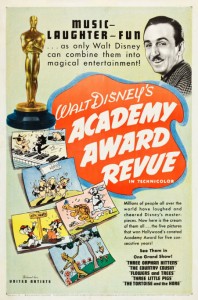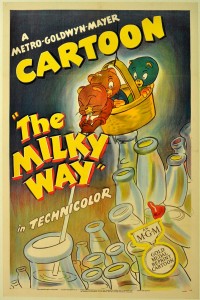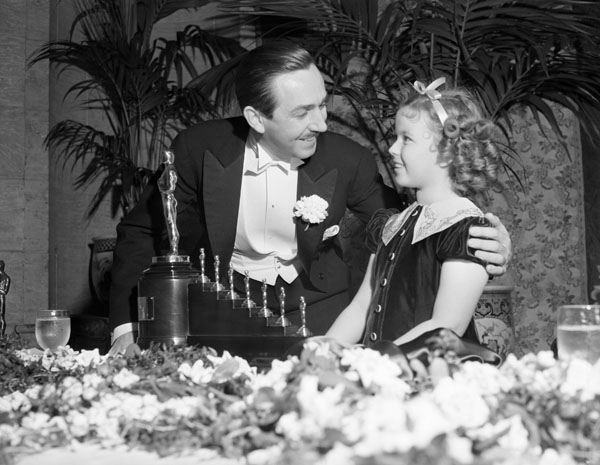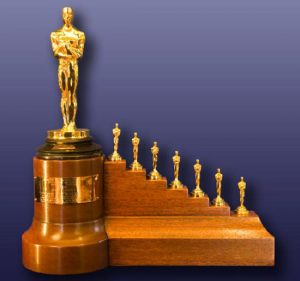Suspended Animation #311
To help promote the upcoming release of Snow White and the Seven Dwarfs later that year, and to remind audiences of the excellence of Disney animation, the Disney Studio released to theaters, for a limited time, a compilation of five Oscar-winning shorts titled Academy Award Revue of Walt Disney Cartoons in May 1937.
 The compilation consisted of Flowers and Trees, Three Little Pigs, The Tortoise and the Hare, Three Orphan Kittens and The Country Cousin. The shorts were bridged together with title cards and a narrator. This compilation was re-released in 1966 and updated with four additional shorts: The Old Mill, Ferdinand the Bull, The Ugly Duckling and Lend A Paw. There was no narration in this version.
The compilation consisted of Flowers and Trees, Three Little Pigs, The Tortoise and the Hare, Three Orphan Kittens and The Country Cousin. The shorts were bridged together with title cards and a narrator. This compilation was re-released in 1966 and updated with four additional shorts: The Old Mill, Ferdinand the Bull, The Ugly Duckling and Lend A Paw. There was no narration in this version.
Believe it or not, Academy Award Revue of Walt Disney Cartoons was released on a bilingual Japanese laserdisc in 1985.
The Academy of Motion Picture Arts and Sciences was the concept of the late movie producer Louis B. Mayer, who decided there was a need for such an organization to give status and respect to the motion picture industry. With the help of other prominent figures in Hollywood, the Academy was created and gave its first, then nameless awards, at a banquet on May 16, 1929.
The Short Subjects Awards were first handed out in 1932 in three categories: Cartoon, Comedy and Novelty. Supposedly, the cartoon category was established primarily to honor the work of Walt Disney. For several years most of the nominees and winners in this category were Disney cartoon shorts, with a token nomination or two to other animation producers like Leon Schlesinger.
For instance, in 1938, four Disney cartoons were nominated: The Brave Little Tailor, Mother Goose Goes Hollywood, Good Scouts, and Ferdinand the Bull. Ferdinand the Bull won and spawned a good deal of merchandise. In fact, Disney won in the cartoon Short Subject category every year from 1932 (Flowers and Trees) to 1939 (The Ugly Duckling).
 The streak was broken in 1940 when MGM’s The Milky Way, about three little kittens who lost their mittens and dream of visiting the Milky Way in a balloon basket, took the award. There were no Disney cartoons nominated that year. The other two nominees in the category were MGM’s Puss Gets the Boot (arguably the first Tom and Jerry cartoon) and Warner’s A Wild Hare (arguably the first “official” Bugs Bunny cartoon).
The streak was broken in 1940 when MGM’s The Milky Way, about three little kittens who lost their mittens and dream of visiting the Milky Way in a balloon basket, took the award. There were no Disney cartoons nominated that year. The other two nominees in the category were MGM’s Puss Gets the Boot (arguably the first Tom and Jerry cartoon) and Warner’s A Wild Hare (arguably the first “official” Bugs Bunny cartoon).
In 1932, besides Flowers and Trees, the other two nominees in the new category were Disney’s Mickey’s Orphans and Warner’s It’s Got Me Again.
Also that year, Walt received a special Oscar from the Academy for the creation of Mickey Mouse. Filmmaker Charlie Chaplin was originally supposed to present the statuette, but had decided to stay home that night.
This moment was a milestone in Oscar history since it was the first year that one man was given two awards at the same ceremony and only the second time a special Oscar had been awarded. (The first special award was given to Chaplin.)
Walt Disney knew ahead of time that he was going to receive two awards. Up until 1941, winners were informed beforehand to help reporters meet their news deadlines.
That year, the fifth annual Motion Picture Arts and Sciences’ banquet was held in the Fiesta Room of the Ambassador Hotel on Wilshire Boulevard on November 18, 1932. Nine hundred people attended.
As part of the festivities, and to show appreciation for the honors he was to receive, Walt produced a short color cartoon for those in attendance. Parade of the Award Nominees, a two-and-a-half minute short specially prepared for the ceremony, featured caricatures of those performers nominated in the Best Actor and Best Actress categories.
Mickey Mouse in green shorts led the parade of nominees (with some recycled animation from the 1931 Silly Symphony Mother Goose Melodies) down a red carpet. It was Mickey’s first color film appearance, pre-dating The Band Concert by several years which is one of the reasons his shorts were green.
In order, the caricatures were Wallace Beery for The Champ (with Jackie Cooper trailing along behind); Alfred Lunt and Lynn Fontanne for The Guardsman; Helen Hayes for The Sins of Madelon Claudet; Fredric March for Dr. Jekyll and Mr. Hyde; and Marie Dressler for Emma.
One newspaper reported that the film garnered a “huge laugh.” Another newspaper reported, “Judging by the applause, the greatest enthusiasm was for Walt Disney, creator of Mickey Mouse, and for Helen Hayes (who won Best Actress).”

At the Biltmore Hotel in Los Angeles on the night of February 23, 1939, was a nervous Walt Disney. He’d already been the recipient of seven Academy Awards from previous years. That night, Walt was presented with an Honorary Academy Award for Snow White and the Seven Dwarfs‘ “significant screen innovation, which has charmed millions and pioneered a great new entertainment field for the motion picture cartoon.”
 Snow White was the top-grossing film of all time at that point, and had become so hugely popular and critically lauded that the Academy felt the film deserved some recognition, but didn’t want to give a Best Picture Oscar (or a nomination in that category) to an animated cartoon.
Snow White was the top-grossing film of all time at that point, and had become so hugely popular and critically lauded that the Academy felt the film deserved some recognition, but didn’t want to give a Best Picture Oscar (or a nomination in that category) to an animated cartoon.
According to his autobiography, Academy President (and legendary film director) Frank Capra was the one who came up with the idea of a special award of a full-sized Oscar statuette with seven smaller ones descending in a row. Even though Walt was adamant that he didn’t make films just for children, but for the entire family, it was felt that the top child star of the time, Shirley Temple, representing all of Walt’s young fans should make the presentation.
According to the caption on a photo distributed to newspapers by Wide World Photos Los Angeles Bureau: “Long applause greeted Shirley Temple when she walked to the rostrum to present a special award to Walt Disney for Snow White and the Seven Dwarfs, which is recognized by the industry as a screen innovation that pioneered a new entertainment field.”
Shirley Temple: I am sure the boys and girls in the whole world are going to be very happy when they find out that the daddy of Snow White and the Seven Dwarfs, Mickey Mouse, Ferdinand, and all the others is going to get this beautiful statue [removes the fabric covering the award]. Isn’t it bright and shiny?
Walt Disney: Oh, it’s beautiful.
Shirley Temple: Aren’t you proud Mr. Disney?
Walt Disney: I’m so proud I think I’ll bust. You know I think that Mickey Mouse, Ferdinand, Snow White and all the dwarves are going to be very proud that you presented it.
Shirley Temple: I’m glad.
The references to “Ferdinand” were to the main character in the Disney animated short cartoon that won that year, Ferdinand the Bull.
Shirley Temple Black told historian John Culhane many years later: “I thought that the big statue was for Walt and that the Seven Dwarfs were the little ones going down the side and that Snow White herself hadn’t gotten anything. I was 11 years old. And I was worried about Snow White at the time, that she hadn’t gotten an Oscar. It’s just that the big one is the one usually presented to who the person is. I mean Snow White wasn’t there.
“We ad-libbed in those days; we didn’t have things written down. I suppose some people would memorize speeches in case they won, in fact I imagine everybody…He [Walt] was a very special guy and I enjoyed him very much. I am just sorry I never worked for him.”


 Jim Korkis is an internationally respected animation historian who in recent years has devoted his attention to the many worlds of Disney. He was a columnist for a variety of animation magazines. With his former writing partner, John Cawley, he authored several animation related books including The Encyclopedia of Cartoon Superstars, How to Create Animation, Cartoon Confidential and Get Animated’s Animation Art Buyer’s Guide. He taught animation classes at the Disney Institute in Florida as well as instructing classes on acting and animation history for Disney Feature Animation: Florida.
Jim Korkis is an internationally respected animation historian who in recent years has devoted his attention to the many worlds of Disney. He was a columnist for a variety of animation magazines. With his former writing partner, John Cawley, he authored several animation related books including The Encyclopedia of Cartoon Superstars, How to Create Animation, Cartoon Confidential and Get Animated’s Animation Art Buyer’s Guide. He taught animation classes at the Disney Institute in Florida as well as instructing classes on acting and animation history for Disney Feature Animation: Florida.




















































Around 25 years ago, my local video shop had a VHS of the 1966 version of Academy Award Revue. I watched it over and over again, marveling at these excellent cartoons that I hadn’t seen since they aired on the Disney TV show in my childhood.
The march that accompanies the “Parade of the Award Nominees” is “Under the Double Eagle” by the Austrian bandmaster Josef Franz Wagner, no relation to the German opera composer Richard Wagner.
I suppose everybody here already knows this, but it bears repeating: Walt Disney won more Academy Awards (22), and was nominated more times (59), than any other individual in history, as well as receiving four honorary Oscars. In second place is art director Cedric Gibbons (who designed the Oscar statuette), with 11 wins from 39 nominations. The second most frequently nominated individual is composer John Williams, with 52 nominations resulting in five wins. Walt Disney’s record at the Academy Awards, like his contributions to film, will never be equaled, much less surpassed.
I think just about all of the awards are available for viewing at the Walt Disney Family Museum in San Francisco. This includes the special Snow White Oscar and also his Medal of Freedom.
That looks like Dick Huemer’s animation of Wallace Beery and Jackie Cooper in the Parade of the Award Nominees. Note how much the design of the Jackie Cooper caricature resembles Scrappy!
Are we counting just the awards Walt Disney received personally as the producer of a film, or also the awards to individual composers, designers, actors, etc. who worked on Disney films? Are we, for example, counting Julie Andrews’s Best Actress win in the total Disney tally?
I faintly recall reading that a studio could purchase an additional Oscar statuette when an individual won for work on the studio’s film, so there’d be one for the studio to show off while the other went on the winner’s mantel.
Walt Disney’s 22 Oscars were awarded to him personally and solely. His 59 nominations were in the categories of Best Short Subject (Cartoon), Best Short Subject (Two-reel), Best Documentary (Short Subject), Best Documentary (Feature), and one Best Picture nomination for “Mary Poppins”. The acting and technical Oscars that have been awarded to other people for their work in his films are not counted in this tally.
Shirley Temple might have remembered it that way, but there is no way is that stilted exchange ad-libbed.